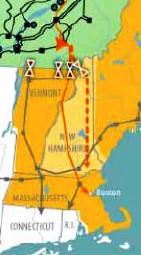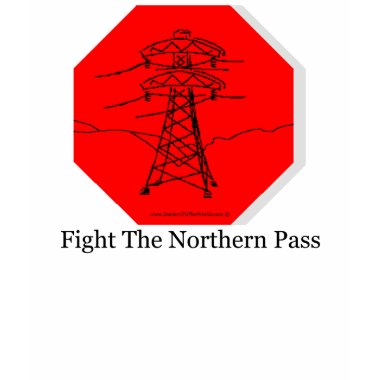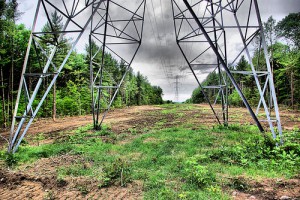FEATURED GUEST BLOG by Sally Manakian,
Backcountry Resource Conservation Manager for the Appalachian Mountain Club, in New Hampshire

The high stakes of high power transmission lines, and time for public input
In recent years, northern New Hampshire residents have struggled with the pros and cons of renewable energy proposals, from wind to biomass. These projects offer jobs, tax revenues, and a commitment to renewable energy sources, but also raise questions of environmental and scenic impact in an area dependent on tourism. Most of all, these proposals inevitably involve the strong land connection of North Country residents for their family farms and historic forests.
The most recent project is quickly becoming the most controversial: a high voltage direct current 1,200 megawatt transmission line connecting New England’s power grid with renewable sources in Quebec, known as the Northern Pass Transmission line. The line, projected to cost $1.1 billion in construction, would meet some of the needs of power-importer states hungry for renewable sources, mostly Massachusetts and Connecticut.


The proposed route of the line crosses the border at Pittsburg, and travels to Franklin by hugging the western border of the state. Using current rights of way, the 140 mile line would require 40 new miles as well as updating the current line to the high voltage direct current capacity towers that are 90-130 feet high.
(What does 90-130 feet high look like? If your average telephone pole comes ¾ of the way up a tree, that same tree comes only 1/3-1/2 of the way up a 130 foot tower.)

The 2010 release of the preliminary routes for the transmission line made the proposal a reality and a controversy for residents of Coos, Carroll, and Grafton counties in New Hampshire. The controversy began when they saw the line cut through scenic vistas and private land in Stewartstown, the local heritage and tourism destination of the Rocks Estate in Bethlehem, the quiet Town of Easton, and the Appalachian Trail as it crosses the Kinsmans in the White Mountain National Forest.
The federal process for this project requires a Presidential Permit for the crossing of an international boundary. The Department of Energy (DOE) must determine that the proposed action is in the public interest, weighing the various impacts as it does so, before a Presidential Permit is issued. AMC has intervened in opposition to the project.

The DOE accomplishes this through an Environmental Impact Statement (EIS), culled in part from public comments, either written or spoken. This past week the DOE held a series of public scoping sessions across the state: Pembroke, Franklin, Lincoln, Whitefield, Plymouth, Colebrook, Haverhill. They were attended by 200, 300, 400 and up to 700 at Plymouth.
If you are interested in submitting written comments, the deadline is April 12. Submit written comments here. In the uniquely New England way, the public scoping sessions were passionate displays of public engagement and politics. AMC staff attended most of the scoping sessions, and I myself attended Plymouth’s and Colebrook’s.
The proposed routes through Colebrook are new rights of way that would invoke eminent domain and the taking of land. Citizens spoke of their love of the landscape and their love of life, and a very tangible fear that their lives will be dangerously affected by this powerline project: affecting the view, affecting their forests, and affecting the land their grandparents are buried on.

One in particular was Mark McCullock; I worked with Mark in the woods in 2010 at Eliza Brook campsite, we ate backcountry meals and we worked as a crew and we built a shelter together. During that time, Mark spoke often of his home, 70 acres of maple trees, ponds, hiking trails, and the house his built with his own hands.
The proposed line would cut directly through his sugar orchard.
When Mark spoke at the EIS scoping hearing in Colebrook, he went over his designated three minutes as he spoke of the effects on his property and his livelihood. The moderator informed him that he was thirty seconds over, a minute over, and eventually that his time was up. Members of the audience shouted out to let Mark continue.
As Mark broke into tears, he said “thank you for giving me three minutes to defend my 25 years on my land.” There is a connection to the land that one develops as a trail worker, a caretaker, a steward. There is a direct feeling of shovel into earth, a disruption to land. The alteration of terrain, expressed at the human powered level.
When I consider the effects of transmission lines, I consider the alteration of terrain. The disruption to ecosystems, an impact that we can’t take back. I see the roads and infrastructure that are created to build the lines, and that stay behind to maintain the lines. I see the visual break in the landscape.
I do not own property in the corridor line, but a proposed route crosses the Appalachian National Scenic Trail in the White Mountain National Forest within half a mile of Eliza Brook Shelter. I have a deep physical connection with all AMC campsites because of the nature of my work, but I also feel an especially deep connection with Eliza, having spent the past field season dedicated to her renewal through rehabilitation and a new shelter.
AMC’s is one of many conservation organizations that have weighed in on the Northern Pass project, including the Appalachian Trail Conservancy, the Society for the Protection of New Hampshire Forests, and N.H. Audobon. In their motions to intervene, they speak powerfully of the need for intact landscapes, ecosystems, and wild recreational experiences. For example, the Appalachian National Scenic Trail is currently facing pressure from energy projects all along the 2,000 miles of its length; the ATC and AMC both asked what the cumulative impact of powerline and wind projects would have on recreation as well as the primitive experience hikers seek during four months on the trail.
There are a variety of ways to educate yourself about the Environmental Impact Statement that the Department of Energy is putting together. There is, also, opportunity for everyone to comment on the process. For those who recreate on or along the Appalachian Trail in the Kinsmans, or who value intact landscapes, your voice should be heard.
Go here to comment in the public scoping period, which ends April 12.
Here are a selection of links to educate yourself more on the project overall:
http://www.northernpass.us/ ; - posted by the developer
http://livefreeorfry.org/ - North Country opposition
burynorthernpass.blogspot.com—Bury Northern Pass (North Country Opposition)
http://www.northernpasseis.us/index.asp - Official U.S. DOE site
http://www.nccouncil.org/ ; - North Country Council
http://www.clf.org/your-state/new-hampshire/ - Conservation Law Foundation
**********************************************************************************************************************

No comments:
Post a Comment